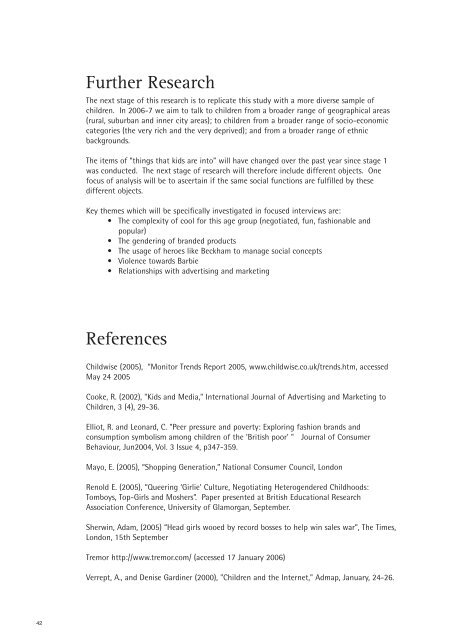The Simpsons are Cool but Barbie's a Minger - Professor Agnes Nairn
The Simpsons are Cool but Barbie's a Minger - Professor Agnes Nairn
The Simpsons are Cool but Barbie's a Minger - Professor Agnes Nairn
You also want an ePaper? Increase the reach of your titles
YUMPU automatically turns print PDFs into web optimized ePapers that Google loves.
42<br />
Further Research<br />
<strong>The</strong> next stage of this research is to replicate this study with a more diverse sample of<br />
children. In 2006-7 we aim to talk to children from a broader range of geographical <strong>are</strong>as<br />
(rural, suburban and inner city <strong>are</strong>as); to children from a broader range of socio-economic<br />
categories (the very rich and the very deprived); and from a broader range of ethnic<br />
backgrounds.<br />
<strong>The</strong> items of “things that kids <strong>are</strong> into” will have changed over the past year since stage 1<br />
was conducted. <strong>The</strong> next stage of research will therefore include different objects. One<br />
focus of analysis will be to ascertain if the same social functions <strong>are</strong> fulfilled by these<br />
different objects.<br />
Key themes which will be specifically investigated in focused interviews <strong>are</strong>:<br />
• <strong>The</strong> complexity of cool for this age group (negotiated, fun, fashionable and<br />
popular)<br />
• <strong>The</strong> gendering of branded products<br />
• <strong>The</strong> usage of heroes like Beckham to manage social concepts<br />
• Violence towards Barbie<br />
• Relationships with advertising and marketing<br />
References<br />
Childwise (2005), “Monitor Trends Report 2005, www.childwise.co.uk/trends.htm, accessed<br />
May 24 2005<br />
Cooke, R. (2002), "Kids and Media," International Journal of Advertising and Marketing to<br />
Children, 3 (4), 29-36.<br />
Elliot, R. and Leonard, C. "Peer pressure and poverty: Exploring fashion brands and<br />
consumption symbolism among children of the 'British poor' " Journal of Consumer<br />
Behaviour, Jun2004, Vol. 3 Issue 4, p347-359.<br />
Mayo, E. (2005), “Shopping Generation,” National Consumer Council, London<br />
Renold E. (2005), “Queering ‘Girlie’ Culture, Negotiating Heterogendered Childhoods:<br />
Tomboys, Top-Girls and Moshers”. Paper presented at British Educational Research<br />
Association Conference, University of Glamorgan, September.<br />
Sherwin, Adam, (2005) “Head girls wooed by record bosses to help win sales war”, <strong>The</strong> Times,<br />
London, 15th September<br />
Tremor http://www.tremor.com/ (accessed 17 January 2006)<br />
Verrept, A., and Denise Gardiner (2000), "Children and the Internet," Admap, January, 24-26.


